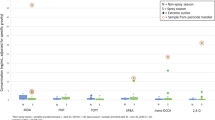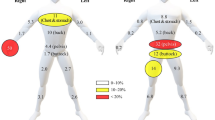Abstract
Chlorpyrifos is the most common organophosphate compound registered for agricultural use in Vietnam. The aim of this study was to evaluate chlorpyrifos exposure to rice farmers in Vietnam, using a probabilistic approach. Urine samples on a 24-h basis were collected from farmers before and post application of pesticide. Samples were analysed for 3,5,6-trichloro-2-pyridinol (TCP), the major urinary metabolite of chlorpyrifos, using an enzymatic pre-treatment for extraction and HPLC-MS/MS. Absorbed daily doses (ADD) of chlorpyrifos for farmers were subsequently estimated from the urinary TCP levels. The baseline and post-application exposure levels were evaluated at the 5th, 50th, and 95th percentile representing low, medium and high-exposure groups in the population. Regression analysis was applied to examine the association between exposure level and factors. The baseline exposure level, which ranged from 0.03 to 1.98 μg/kg/day was below the chronic guidelines recommended by international and national bodies. However, the post-application exposure level, which ranged from 0.35 to 94 μg/kg/day exceeded most of the acute guidelines at the 95th percentile level. Multivariate analysis provided strong evidence for a relationship between post-application exposure level and amount of chlorpyrifos used, as well as body coverage of personal protective equipment.
This is a preview of subscription content, access via your institution
Access options
Subscribe to this journal
Receive 6 print issues and online access
$259.00 per year
only $43.17 per issue
Buy this article
- Purchase on Springer Link
- Instant access to full article PDF
Prices may be subject to local taxes which are calculated during checkout





Similar content being viewed by others
References
Dung N.H., The Case of Farmers in Rice Production in the Mekong Delta Vietnam. Sub-Regional Conference on Proverty Environment Nexus - LAO PDR. 2006.
Hung H.T., Du N.T., and Hojer J. The first poison control center in vietnam: experiences of its initial years. Southeast Asian J Trop Med Public Health 2008: 39: 310–317.
VN Mard The registration list of pesticides in Vietnam in 2009. 2009.
Phung D., Miller G., Hodgec M., Patelc R., Cheng R., and Abeyewardenec M., et al. Biological monitoring of chlorpyrifos exposure to rice farmers in Vietnam. Submitted in September, 2011. Chemosphere. 2011.
ATSDR. Toxicological Profile for Chlorpyrifos. U.S.Department of Health and Human Services, Agency for Toxic Substances and Disease Registry. Public Health Service: Atlanta, 1997.
Aponso M.L. Exposure and risk assessment for farmers occupationally exposed to chlorpyrifos. Annals of the Sri Lanka Department of Agriculture 2002: 4: 233–244.
Whyatt R.M., Rauh V., and Barr D.B. Prenatal insecticide exposures and birth weight and length among an urban minority cohort. Envi Health Persp 2004: 112: 1125–1132.
Slotkin T.A., Levin E.D., and Seidler F.J. Comparative developmental neurotoxicity of organophosphate insecticides: effects on brain development are separable from systematic toxicity. Envi Health Persp 2006: 114 (5): 746–751.
Rawlings N.C., Cook S.J., and Waldbillig D. Effects of the pesticides carbofuran, chlorpyrifos, dimethoate, lindane, triallate, trifluralin, 2,4-D, and pentachlorophenol on the metabolic endocrine and reproductive endocrin system in ewes. J Tox Envi Health 1998: 54: 21–36.
Alavanja M.C., Samanic C., Dosemecil M., Lubin J., Tarone R., and Lynch C.F., et al. Cancer: possible association with increase risk of prostate cancer. Use of agricultural pesticidesand prostate cancer risk in the agricultural health study cohort. Am J of Epidem 2003: 157.
Lee W.J., Blair A., Hoppin J.A., Rusiecki J.A., Sandler D.P., and Dosemeci M., et al. Cancer incidence among pesticide applicators exposed to chlorpyrifos in the Agricultural Health Study. J Natl Cancer Inst 2004: 96: 1781–1789.
Cao Q., Yu Q., and Connell D.W. Health risk characterization for environmental pollutants with a new concept of overall risk probability. J Hazard Mater 2011: 187: 480–487.
Connell D., Wong B., Lam P., Rocharson B., Wu R., and Yen Y. Risk to breeding success of ardeids by contaminants in Hong Kong: evidence from trace metal in feathers. Ecotoxicology 2002: 11: 49–59.
Hamidin N., Yu Q.J., and Connell D.W. Human health risk assessment of chlorinated disinfection by-products in drinking water using probabilistic approach. Water Res 2008: 42: 3263–3274.
Klaassen C.D., Amdur M.O., and Doull J. Casarett & Doull's Toxicology: The basic science of poisons, 3rd Ed, Macmillan Publishing, New York, 1986.
VN Monre, EHN Vietnam Vietnam Environmental Protection Agency. National Report on Environmental Health. Hanoi, Vietnam, 2006.
Barr D.B., Barr J.R., Driskell W.J., Hill R.H., Ashley D.L., and Needham L.L. Strategies for biological monitoring of exposure for contemporary-use pesticides. Toxicol Ind Health 1999: 15: 168–179.
Barr D.B., Thomas K., Curwin B., Landsittel D., Raymer J., and Lu C., et al. Biomonitoring of exposure in farmworker studies. Envi Health Persp 2006: 114: 936–942.
Barr D.B., Wilder L.C., Caudill S.P., Gonzalez A.J., Needham L.L., and Pirkle J.L. Urinary creatinine concentrations in the U.S. population: implications for urinary biologic monitoring measurements. Envi Health Persp 2005: 113: 192–200.
Elitech RE: Creatinine Jaffe. 2005.
Mage D.T., Allen R.H., Gondy G., Smith W., Barr D.B., and Needham L.L. Estimating pesticide dose from urinary pesticide concentration data by creatinine correction in the Third National Health and Nutrition Examination Survey (NHANES-III). J Expo Anal Environ Epidemiol 2004: 14: 457–465.
Curwin B.D., Hein M.T., Sanderson W.T., Striley C., Heederil D., and Kromhout H., et al. Pesticide dose estimates for children of Iowa farmers and non-farmers. Environ Res 2007: 105: 307–315.
Graber M.A., Toth P.P., and Herting R.L. University of Iowa Family Practice Handbook, 3rd Edition, Department of Family Medicine, University of Iowa College of Medicine, Iowa, USA, 1997.
Farahat F.M., Ellison C.A., Bonner M.R., Macgarrigle B.P., Crane A.L., and Fenske R.A., et al. Biomakers of chlorpyrifos exposure and effects in egyptian cotton field workers. Envi Health Persp 2011: 119: 801–806.
Alexander B.H., Burns C.J., Bartels M.J., Acquavella J.F., Madel K.S., and Gustin C.A., et al. Chlorpyrifos exposure in farm families: results from the farm family exposure study. J Expo Sc Environ Epidemiol 2006: 16: 447–456.
Rodriguez T., Younglove L., Lu C., Funez A., Weppner S., and Barr D.B., et al. Biological minitoring of pesticide exposures among applicators and their children in Nicaragua. Int J Occup Environ Health 2006: 12: 312–320.
Nolan R.J., Rick D.L., Freshour N.L., and Saunders J.H. Chlorpyrifos: Pharmacokinetics in human volunteers. Toxicol Appl Pharmacol 1984: 73: 8–15.
Zahm S.H., and Blair A. Occupational cancer among women: where have we been and where are we going? Am J Ind Med 2003: 44: 565–575.
Cleveland C.B., Oliver G.R., Chen B., and Mattsson J. Risk assessment under FQPA: case study with chlorpyrifos. NeuroToxicol 2001: 22: 699–706.
FAO/WHO. The 1998 joint meeting of the FAO panel of experts on pesticide residues in food the environment and the WHO CORE Assessment Group. World Health Organization, Rome, 1998.
NPIC Chlorpyrifos Technical Fact Sheet. 2009.
NRA National Registration Authority. NRA review of chlorpyrifos. Canberra. 2000.
Panuwet P., Propamontol T., Chantara S., Thavomyuthikarn P., Montesano M.A., Whitehead R.D., and Barr D.B. Concentration of urinary pestrcide metabolites in small-scale farmers in Chiang Mai Province, Thailand. Sci Total Environ 2008: 407: 655–668.
Acknowledgements
We are grateful to Australian Endeavour Post Graduate Award; Griffith School of Environment; and in-kind contribution of Emeritus Professor Des Connell for financial support to the study, and authors are highly appreciate to colleagues at Administration of Preventive Medicine, Vietnam Ministry of Health; Thai Binh Preventive Medicine Centre; Kien Xuong District Medical Centre; Vu Le Commune Health Clinic; and Thai Binh Medical University for valuable support and assistance in the sampling program.
Author information
Authors and Affiliations
Corresponding author
Ethics declarations
Competing interests
The authors declare no conflict of interest.
Rights and permissions
About this article
Cite this article
Phung, D., Connell, D., Miller, G. et al. Probabilistic assessment of chlorpyrifos exposure to rice farmers in Viet Nam. J Expo Sci Environ Epidemiol 22, 417–423 (2012). https://doi.org/10.1038/jes.2012.32
Received:
Accepted:
Published:
Issue Date:
DOI: https://doi.org/10.1038/jes.2012.32
Keywords
This article is cited by
-
The usage of insecticides and their health impacts on farmers and farmworkers: a scoping review
Journal of Public Health (2023)
-
Environmental monitoring and potential health risk assessment from Pymetrozine exposure among communities in typical rice-growing areas of China
Environmental Science and Pollution Research (2022)
-
Body fluids from the rat exposed to chlorpyrifos induce cytotoxicity against the corresponding tissue−derived cells in vitro
BMC Pharmacology and Toxicology (2021)
-
Assessment of occupational exposure to pesticides applied in rice fields in developing countries: a critical review
International Journal of Environmental Science and Technology (2021)
-
Income, wealth and use of personal protection equipment in the Mekong Delta
Environmental Science and Pollution Research (2021)



